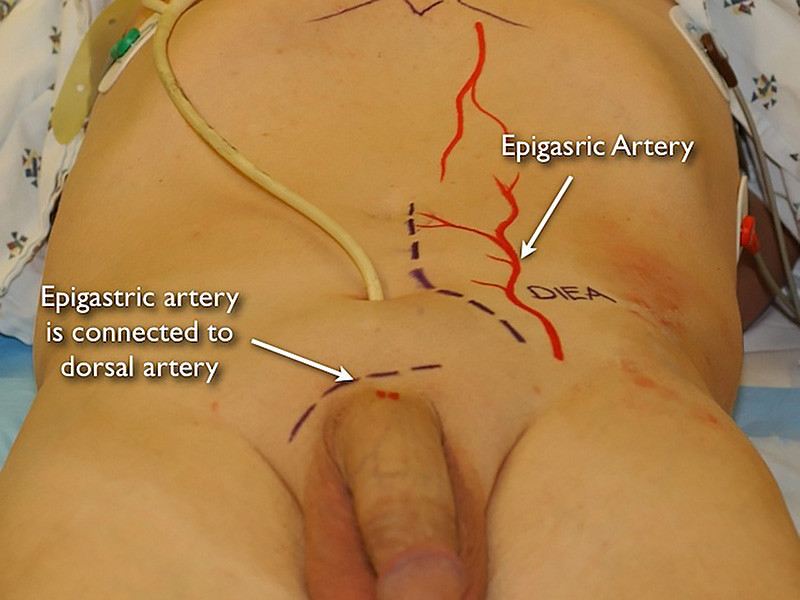What is Penile Revascularizaton?
Penile arterial revascularization surgery for erectile dysfunction is an operation to improve arterial blood flow to the penis. An artery located in the lower abdomen called the inferior epigastric artery is mobilized and then connected (the connection is called an anastomosis) to an artery at the base of the top of the penis (proximal dorsal penis) called the dorsal artery. This surgery is also called penile microvascular arterial bypass surgery.
Penile revascularization is a concept that appeals to many men with erectile dysfunction (ED) and we are often contacted by men with ED wanting to know the cost of the surgery and when it could be scheduled. It makes sense that many men who have not been appropriately counselled would feel that penile revascularization surgery could cure their erectile dysfunction. Since the penis is not filling with enough blood to cause a firm erection, it would seem that if more blood could enter the penis by an increase in artery inflow, this would be an erectile dysfunction cure.
However, penile arterial revascularization surgery will generally not cure or effectively treat ED, and this surgery is not indicated for the vast majority of men with erectile dysfunction. Men with erectile dysfunction related to diabetes, hypertension, and atherosclerosis and other conditions generally have diffuse vascular disease and would not benefit from this surgery. In many cases, vascular ED is related to venous leak (a vein problem) and this is not effectively treated with penile revascularization surgery. Moreover, ED related to nerve injury (eg. after prostate removal for prostate cancer) will not be effectively treated with a penile microvascular arterial bypass surgery.
Penile revascularization is most appropriate for certain men who sustain pelvic fracture trauma and suffer associated vascular injuries that reduce blood flow to his otherwise normal penis. This surgery is performed at our Center by Dr. Gelman and Dr. Mark Kobayashi, a microvascular surgeon at UC, Irvine Medical Center.

In penile microvascular arterial bypass surgery, the epigastric artery is connected to the dorsal artery of the penis, increasing blood flow to the penis.
When penile revascularization surgery is performed, an incision is made above the penis, and the dorsal arteries that course along the top of the penis under the skin are exposed and isolated. A second incision is made along the abdomen and an artery called the inferior epigastric artery is isolated. This is an artery that gives blood supply to the abs (rectus abdominus muscle). Fortunately, the abs can function normally without this artery as other blood vessels also supply this muscle. These 2 arteries are then connected under an operating microscope. Penile revascularization is accomplished because blood from the epigastric artery (with good blood flow) brings increased blood flow to the dorsal artery of the penis (that has poor blood flow).
When men break their pelvis (pelvic fracture) from motor vehicle accidents or crush injuries, these injuries can be associated with arterial injuries (but also nerve injuries) that cause ED. A certain percentage of these men also have damage to their urethra where it is severed just under the prostate, and this is called a pelvic fracture urethral injury, or PFUI. The treatment of PFUI is called a posterior urethroplasty, an operation to remove the scar tissue between the severed ends of the urethra, and the reattachment of the 2 ends of the urethra back together. We evaluate patients with pelvic fracture urethral injuries and ED with testing, and if there is severe artery damage, this may be associated with poor blood flow to the urethra. In certain cases, penile revascularization is indicated prior to posterior urethroplasty to insure there is good blood flow for healing. As a bonus, this may help treat the associated erectile dysfunction. However, even in cases of PFUI, penile revascularization is rarely indicated.

